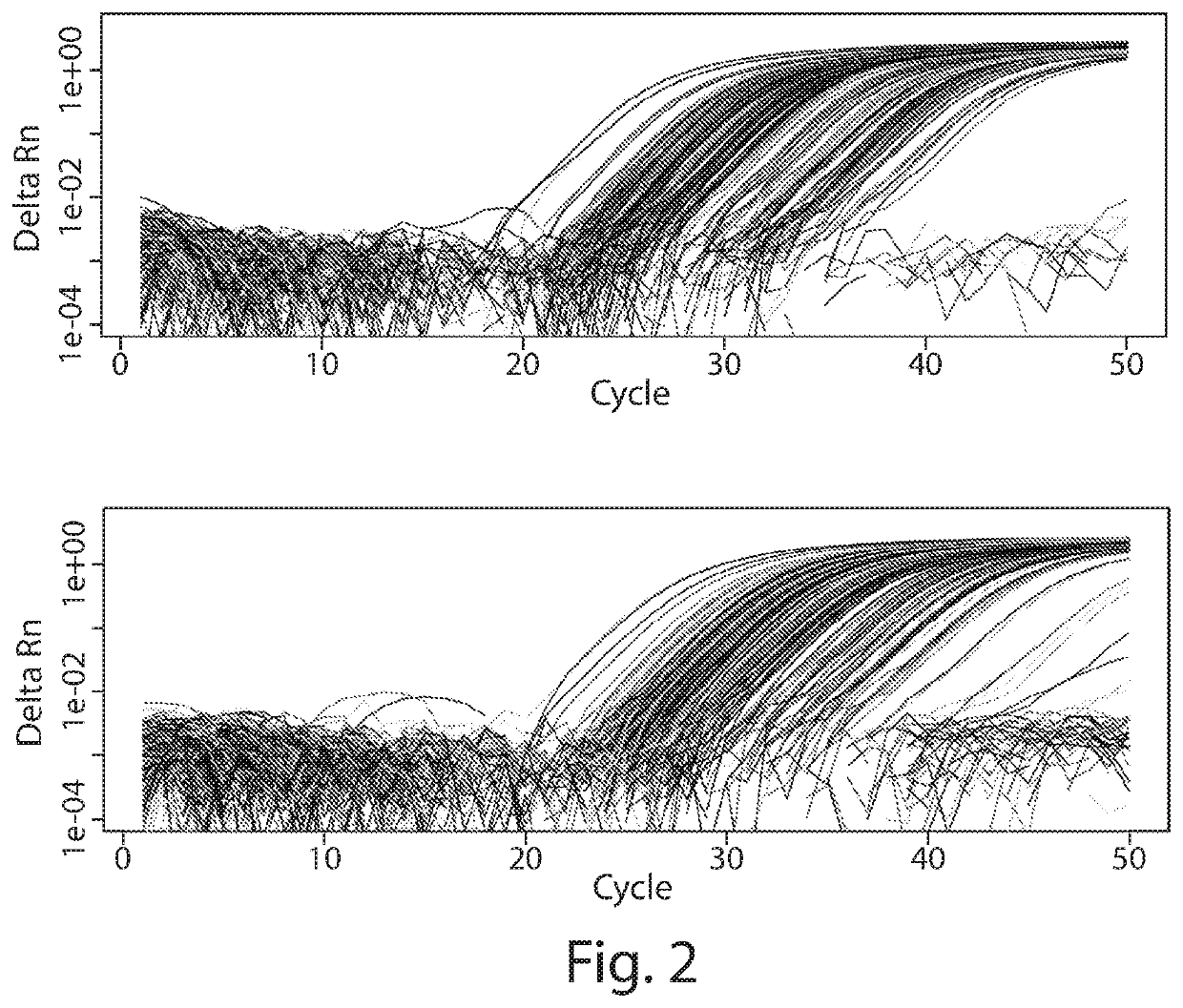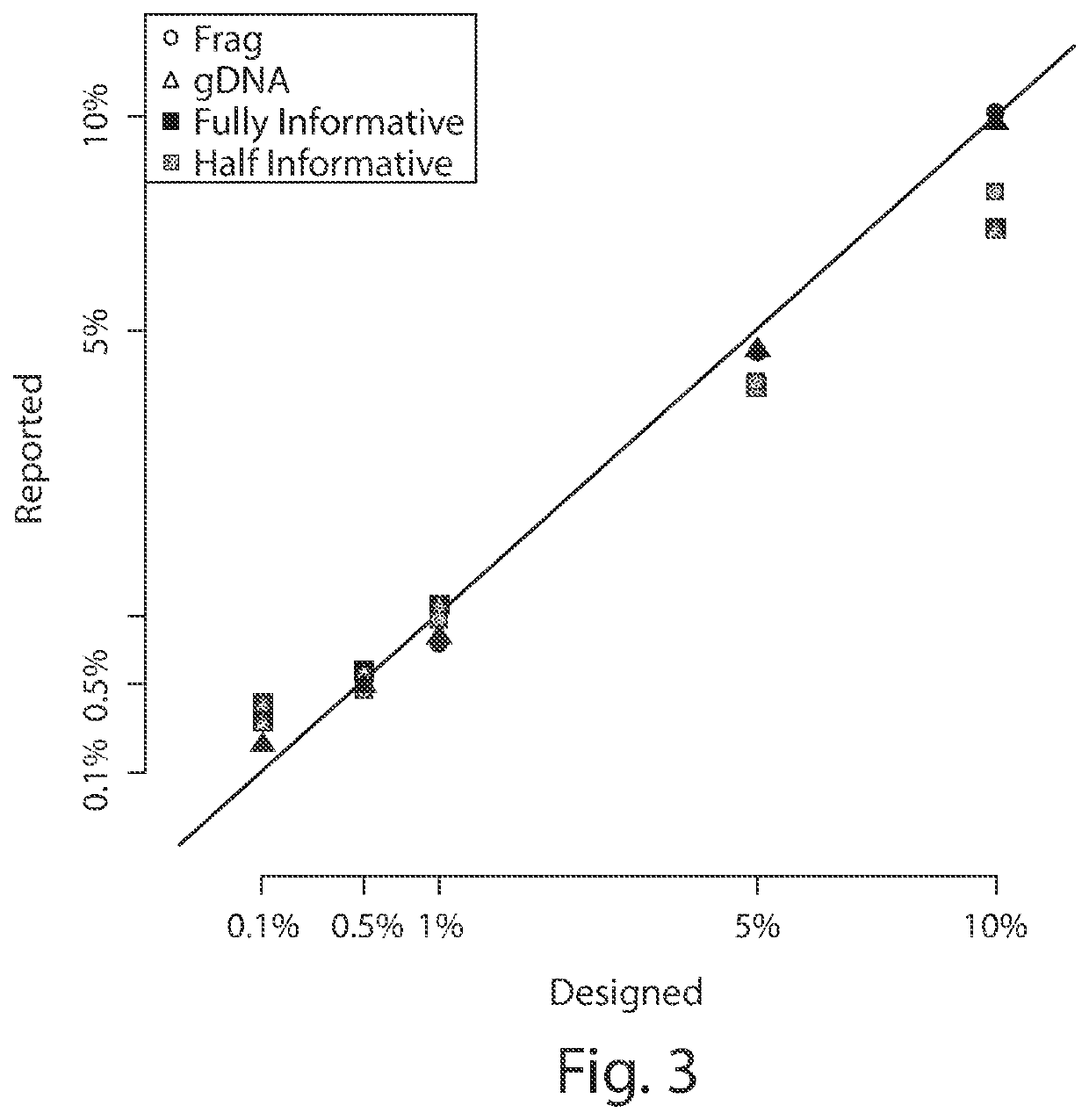Methods for assessing risk using mismatch amplification and statistical methods
- Summary
- Abstract
- Description
- Claims
- Application Information
AI Technical Summary
Benefits of technology
Problems solved by technology
Method used
Image
Examples
example 1
pient and Donor Genotype Information
[0147]SNV Target Selection
[0148]Identification of targets for multiplexing in accordance with the disclosure may include one or more of the following steps, as presently described. First, highly heterozygous SNPs can be screened on several ethnic control populations (Hardy-Weinberg p>0.25), excluding known difficult regions. Difficult regions include syndromic regions likely to be abnormal in patients and regions of low complexity, including centromeres and telomeres of chromosomes. Target fragments of desired lengths can then be designed in silico. Specifically, two 20-26 bp primers spanning each SNP's 70 bp window can be designed. All candidate primers can then be queried to GCRh37 using BLAST. Those primers that were found to be sufficiently specific can be retained, and monitored for off-target hits, particularly at the 3′ end of the fragment. The off-target candidate hits can be analyzed for pairwise fragment generation that would survive siz...
example 2
pient but not Donor Genotype Information
[0159]To work without donor genotype information, the following procedure may be performed to infer informative assays and allow for quantification of donor-specific cell-free DNA in plasma samples. All assays were evaluated for performance in the full information scenario. This procedure thus assumed clean AA / AB / BB genotypes at each assay and unbiased behavior of each quantification. With recipient genotype, assays known to be homozygous in the recipient were selected. Any contamination was attributed to the donor nucleic acids, and the assay collection created a tri-modal distribution with three clusters of assays corresponding to the non-, half, and fully-informative assays. With sufficient numbers of recipient homozygous assays the presence of donor fully informative assays can be assumed.
[0160]If recipient genotype is homozygous and known, then if a measurement that is not the recipient genotype is observed, the probes which are truly don...
example 3
ction Experiments with Trimmed Mean, Median and Untrimmed Mean
[0166]A reconstruction experiment was performed, wherein two samples of DNA were mixed at varying proportions to test the accuracy and precision of MOMA assays. The results are presented below with three types of output measure, the trimmed mean, the median, and the untrimmed means.
SamplesTrimmedRawIntendedUsefulof RunMeanMedianMeanPercentageTargetsTube1101.90%99.97%102.53%100.00%21Tube29.66%10.03%9.77%10.00%21Tube34.83%4.81%5.00%5.00%21Tube40.96%0.95%0.96%1.00%21Tube50.58%0.55%0.67%0.50%29Tube60.16%0.10%1.02%0.10%19Tube70.09%0.02%0.92%0.00%18Tube8NaNNANaNNone0Tube92.05%1.91%2.20%2.00%25Tube101.86%1.71%2.11%1.75%30Tube111.41%1.44%1.44%1.50%29Tube121.21%1.23%1.26%1.25%30Tube130.79%0.81%0.84%0.75%27Tube140.27%0.25%0.29%0.25%29
[0167]Tube 8 had no DNA, the negative control sample accurately reflects a lack of useful targets and “NA” for the donor %. The trimmed mean drops two of the lowest reporting targets and two of the hig...
PUM
| Property | Measurement | Unit |
|---|---|---|
| Time | aaaaa | aaaaa |
| Time | aaaaa | aaaaa |
| Fraction | aaaaa | aaaaa |
Abstract
Description
Claims
Application Information
 Login to View More
Login to View More - R&D Engineer
- R&D Manager
- IP Professional
- Industry Leading Data Capabilities
- Powerful AI technology
- Patent DNA Extraction
Browse by: Latest US Patents, China's latest patents, Technical Efficacy Thesaurus, Application Domain, Technology Topic, Popular Technical Reports.
© 2024 PatSnap. All rights reserved.Legal|Privacy policy|Modern Slavery Act Transparency Statement|Sitemap|About US| Contact US: help@patsnap.com










